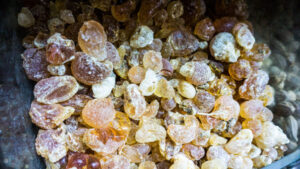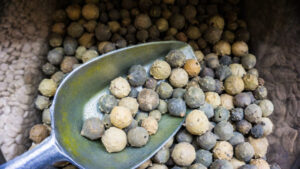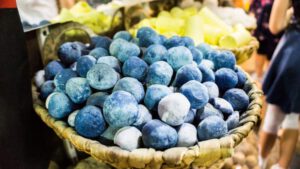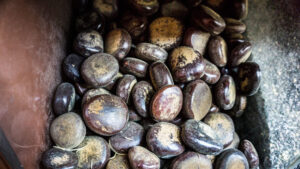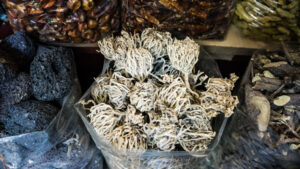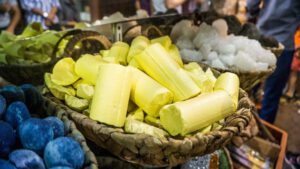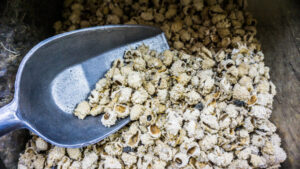Learn about 9 bizarre things you can buy at the Dubai Spice Souk
While the Dubai Spice Souk on the Deira side of the creek is home to sacks of spices like cinnamon and ginger that are common knowledge around the world, its aromatic alleys also hide a number of strange, uncommon ingredients that are used in traditional cooking and medicine. Ever heard of black buttermilk cheese? Or the ‘hand of Maryam’? Or tried eating the cocoons of beetles? We take a virtual visit to this local souk with two expert guides from our Dubai Souks and Creekside Food Walk, Tanya Rehman (@tanyarehman) and Nahla Tabbaa (@nahlatabbaa), to get their take on the most curious discoveries they’ve stumbled upon at the souk.
Links mentioned on the podcast:
-
- Grab a copy of The Ultimate Guide to Dubai’s Spice Souk here: https://www.fryingpanadventures.com/tour/soukguide/
Want more of our scrumptious podcast episodes? Feast on our main podcast page here!
Subscribe on: Apple Podcast App | Spotify (available on AppStore and Google Play) | Google Play Music(currently supported only for listeners in US/Canada) | Anghami
Black Dried Buttermilk Cheese: Qara Qoroot
These individually-wrapped black blocks are a byproduct of yoghurt and buttermilk production formed by boiling down whey until it dries and concentrates into this blackish-brown substance.
Know about how this intensely flavoured ingredient is used it on our podcast or read it in the transcript.
Alum Crystals
Alum can be used to settle suspended impurities in standing water and as a mild disinfectant and astringent when rubbed over one’s skin after a shave.
Nahla shares some amazing properties this mineral can impart when used with pigments on the podcast episode or you can read what she’s discovered in the transcript.
Gum Arabic
Gum Arabic is a dried and hardened tree sap that has been used from ancient times for various purposes. Nahla talks about its use in cooking and color application while Arva recounts her trials with another kind of gum, Gum Tragacanth, as a post-pregnancy folk remedy on the podcast.
There’s more than one type of resinous gum available in the souk, check out our digital Ultimate Guide to Dubai’s Spice Souk to know how to tell them apart.
Oak Galls
These odd and alien-looking orbs are formed by Oak trees when they perceive a particular insect infestation. The hard and knobbly “Dead Sea Apples” are traditionally used in dyeing and tanning.
Listen to our podcast or read the transcript to learn how Nahla experimented with them.
Indigo
You want to avoid touching these blue balls of indigo in souk, but not because they are dangerous. In fact, it’s quite the opposite as they have both cosmetic and domestic applications. The intense blue is quite hard to get off the skin and frankly with this particular Dubai Spice Souk staple, a little goes a long way.
On our podcast and transcript our guides dive into how indigo’s used beyond dyeing and pigmentation.
Nicker Bean or Sea Bean
These mysterious, glossy, misshapen hockey pucks are in fact the gigantic seeds of leguminous plants from Africa that are distributed far and wide by ocean currents.
Hear Tanya talk about the unexpected uses of this buoyant seed as a backache remedy on our podcast or read about it in the show transcript.
Flower of Maryam
Possibly the strangest looking things in the Dubai Spice Souk are the dehydrated Keff Maryam plants. Often referred to by the vendors as the ‘flower of Maryam’ or ‘hand of Maryam’ for its association with the Virgin Mary.
Tanya gets into the details of how this dormant plant helps in relieving child labour pains our the podcast (or read the transcript.)
Sulphur
Don’t be fooled by appearances, these fluorescent yellow sticks aren’t made of colored chalk. A strong sniff will make it clear that this is sulphur, an ingredient long used for cosmetic purposes.
Jump to the podcast or read more in the transcript.
Trehala Manna
Another mysterious ware with Biblical connections are these strange husks, tucked away in stores frequented by the most discerning of customers. While they are sweet and meant to be sucked on like lozenges, make sure to give them a once over before popping them in your mouth as they are in fact a type of beetle cocoon and sometimes may still have one inside!
Arva tells us why you might consider chewing one on our podcast or read further in the transcript.
Not a fan of audio? Here’s the show transcript for you to read!
- Jump directly to specific bizarre things you can buy at the Dubai Spice Souk:
- Black Dried Buttermilk Cheese: Qara Qoroot
- Natural Fixatives for Dyes: Alum and Gum Arabic
- Small Grey Golf Balls: Oak Galls
- Blue Balls/Spheres in the Souk: Indigo
- Smooth Pebbles or Skipping Stones: Nicker Bean or Sea Bean
- Tumbleweed-like Resurrection Plant: Flower of Maryam
- Yellow Sticks: Sulphur
- Cocoons of Beetles: Trehala Manna
Arva: This show is brought to you by Dubai’s most gluttonous food tour company, Frying Pan Adventures, and you’re listening to Deep Fried.
Hey there, I’m your host Arva. And thanks for joining me on the show, that’s inspired by flavors of the East. This podcast serves up the foods that the storytellers, content creators and tour guides on our team at Frying Pan Adventures love sharing about old Dubai.
Today I am joined by two of our food tour guides who’ve taken hundreds of people through the aromatic alleys of the spice souk in the city. They’re going to share some of the most curious stuff that they’ve spotted in the souk and how these strange things are actually put to use.
And the two ladies are: the artist and curator, Nahla Tabbaa, who brings the culinary powers of her joint Jordanian and Bangladeshi heritage to her kitchen and to our food tours.
And Singapore and Dubai kid Tanya Rahman, a banker by trade, but a diehard Indian food lover and home chef by passion. Hey ladies. How’s it going?
Nahla: Hi Arva, all good.
Tanya: I’m good Arva. I’m excited to be talking about spices.
Arva: Alright, welcome back to the show, Tanya and Nahla.
Before you both start telling us about all the eccentric stuff that you found at the souk, I want to first share a story and I’m going to be shamelessly transparent. This is also a plug for something that we’ve been working on a Frying Pan Adventures for a long time. So six years ago, this is during those dark ages before the two of you joined the team, we had this really enthusiastic intern who convinced us to bring her on board during the dead of the summer when nothing is really happening here.
The Ultimate Guide to Dubai’s Spice Souk
Anyway, so lovely Rhea comes on board and then we end up creating the perfect summer project for her. And that was to document every single, curious spice that you find at Dubai’s Spice Souk, to get their scientific names, what they called in arabic, urdu and farsi, which are some of the languages that are spoken at the souk and then how they’re used.
Long story short, that project eventually became a handy little pocket guide, which is what you both got as training material when you joined the team and now that guide has gone online. So we’ve called it “The Ultimate Guide to Dubai’s Spice Souk”, and people can access it through a web browser or we’ve got this really snazzy mobile app for Android, as well as Apple.
And for you folks who are listening in, you’re probably thinking this is some sort of encyclopedic thing that’ll put you to sleep after the first two pages, but actually it’s not. It’s a tiny little digital guy that has just enough info to make you dangerous on 74 ingredients of the souk. And it’s got stunning photos that will make you feel like you’re standing, right in front of those vibrantly colored sacks of spices at the souk.
You can grab that guide on our website at www.fryingpanadventures.com and we’ll also make sure to include a link in our show notes. Alright, so plug aside, Nahla, tell us what are some of the most interesting things you found at the souk?
Black Dried Buttermilk Cheese: Qara Qoroot
Nahla: Okay, well I’m going to start with qara qoroot, which I’ve been very brave about. I’ve put this in an airplane, I’ve introduced this in workshops, I’ve managed to convince guests to buy this, okay and I know what you were going to say Arva, because what you’re talking about is whey that’s been boiled and strained into this black block.
Smell-wise, scent-wise, it smells like a thousand year old socks and old cheese and has the power of like a hundred lemons, honestly. Eat it on its own, it’s going to taste a little bit like marmite, that’s kind of a similarity that I got. Use it in your stews, and honestly it just creates this depth of flavor and acidity that you’re not going to get with anything else.
Arva: And when you’re saying whey, we’re talking about curds and whey so it’s a by-product of boiling and boiling and boiling that whey down, I believe, until you get this really ominous looking black block. Which like you said, it smells like nothing you want to really keep in your pantry. So I’m shocked, I’m actually shocked that you convinced people to buy this.
Nahla: Yep and convinced people to taste this and use it in pretty much a lot of their foods.
Tanya: Okay but it, I mean, it honestly has a very strong scent Nahla. So, if you were to leave it in your pantry—apart from driving guests away—how do you think is the ideal way to store it so that, you know, people actually show up at your house to eat it?
Nahla: Well, I haven’t stored it in my pantry. I’m just one of those horrible people..
Arva: ..who convince other people but you don’t have it..
Nahla: ..that convinces people to..
Arva: “You buy it, but I’m not gonna.. I’m just gonna pass on this one.”
Nahla: Nope, my recommendation though: put it in three Ziploc bags, put those Ziploc bags inside a tight container and then store it in a cool, dry place. Or like at the back of your fridge next to the fridge odor, scent-remover thing.
Arva: It’s a very Persian ingredient, so do you have any thoughts on traditional Persian dishes that this goes into? So I’m guessing people are adding it in there because it adds sourness to a dish. Where have you seen it being used?
Nahla: So I’ve had to consult the oracle, Mr. Reza and he sent me a voice note, which I will shamelessly share with you.
Arva: Alright, so let’s play this voice note, and for reference, Mr. Reza is the vendor, the man behind our favorite persian nuts and saffron ice cream shop in Deira.
So we’re going to play this little message from him.
Mr.Reza: Salam dear, how are you? Wallah, miss you. It’s not fair. Longtime, you are not coming here. Please come, we said we will drink some tea.
Qara qoroot we are having like that, as you know, we Iranian people love to have the all sour things. So we have like that and so it’s full of the calcium.
So the second use, it’s using for the cooking also—we do stew by the name of ghalieh mahi. So this ghalieh mahi stew, we’ll add some qara qoroot also. Tamarind, qara qorootand some special vegetables and fish and it’s a little spicy also. That is from the South of Iran. Qara qoroot—qara it means black, so qoroot that is a desert yogurt or kashk. So qara qoroot is a black kashk, actually, this is the meaning of the name also.
Arva: Okay, so that makes sense, using something as acidic as qara qoroot in a fish stew.
Have you seen it in any other application, Nahla?
Nahla: So, I’ve also seen it being recommended in aash, which is a meat and herb soup. But honestly, I’ve just encouraged people to just have a go with it. Add a little bit of boiling water to it, to just dilute it and then incorporate it into your dips, into your stews.
Arva: I feel like it’s the perfect wildcard ingredient to throw into a Masterchef basket.
Nahla: Exactly. Absolutely. And I have done that to people where I would kind of get them to taste it and see if they could guess what’s on earth this was?
Arva: Alright, so that was qara qoroot, which is definitely one of the most adventurous ingredients that you’re going to find at the souk. It literally translates into ‘black curd’.
Alright, what else do you have for us Nahla?
Natural Fixatives for Dyes: Alum and Gum Arabic
Nahla: So I’m going to take you down another trajectory. Last summer, I took a course on the alchemy of pigment making and I was blown away by the fact that the souk alone presented so many raw materials that could be combined to make colors that could last thousands of years and actually contributed to the way color has been made for centuries and centuries.
So the two main things that you’ll find in the souk that will bind any color and make it last a long time is alum. So alum, we have also discovered can be used as a deodorant as an antiseptic, but combine it with something like hibiscus, for example, you get this, like, deep green. Like this, this crazy chemical reaction.
You also have gum..
Arva: Wait, sorry, sorry. If you combine alum with—an alum is sort of this transparent crystal-like thing—aluminium sulfate. If you combine that, you’re saying, with roselle or with the sepals of the hibiscus fruit which is very sort of, it’s got a mix of purple and magenta. Yeah. You’re going to get a green?
Nahla: Yes!
Arva: That’s wild!
Nahla: It is wild, yeah. Add gum arabic to any mixture—so gum arabic, we use it in many ways. We use it as a binding agent, a glue, something you ingest as well. It will give the color its luster and its shine and also get it to just stick onto things and latch on to things. So with those two main materials, I’ve combined them with all kinds of things.
Small Grey Golf Balls: Oak Galls
I’ve explored making color from Indigo that you could find in the souk, the safflower, turmeric, even the oak galls, which is this, another weird and wonderful ingredient where the oak tree will react to a certain insect laying eggs on its stems and it will produce its own little, I don’t know, pimples.
Arva: Yes, it’s a kind of wasp. A wasp has to lay an egg on the oak tree and then it has a reaction which develops into sort of, for lack of a better description..
Nahla: A boil, literally, a pimple.
Arva: Exactly.
Nahla: Okay, so I took these boils and I slow-cooked them down for about an hour. They produce the deepest black ink I’ve ever, just, produced.
Arva: That’s intense. I just want to clarify these boils are not soft and wobbly, they’re actually hard. They’re like tiny little golf balls, like really, really small. So it’s not all bad.
Nahla: No, exactly.
Arva: Wow, that’s really amazing.
You know, you mentioned gum arabic and I remembered one of the things that was given to me post-pregnancy, so after I delivered my baby and I’m not sure which kind of gum it is, we just call it gond in hindi.
So I don’t know if it’s gum arabic or gum tragacanth, whether you can use both, because there are different types of gums at the souk. But what they would do is they would fry up the gum into almost like crunchy popcorn-like sweet, sweet crystals. And you just sort of crunch on them and it’s supposed to be really good for helping your body get back on track.
Because you know, when you’ve gone through labor pains and you’ve gone through delivery, you’ve pretty much broken your body and this is one of those things that’s supposed to help it heal and come back again, especially for your back and so on. And I really enjoyed it for the first month and then after that, I couldn’t see it again.
Tanya: But what, like deep-fry, pan-fry add in some red chili?
Arva: No, no, no—you don’t add in red chillies. It’s more of a sweet thing.
Actually, I don’t know, maybe someone does add in red chilli, but we didn’t. It was these crunchy sweet crystals. That’s all it is. And it’s weird because bits of it will get stuck to your molars because it is gum, it’s gum.
So it’s chewy, but it’s crunchy. It’s a very interesting, it’s a fascinating texture and grandmums and mums will swear by this. Like “you have to.” If there was a day that I just didn’t feel like having it, all hell would break loose because it was one of those things that was considered critical to my recovery process.
Nahla: And Arva, did you buy the packaged and clean one? Because what you get in the souk is also the rudimentary version that still has insect legs inside it.
Tanya: Oh my goodness!
Nahla: Sorry.
Tanya: Arva, maybe that’s what’s helping you get back on your feet.
Arva: Yeah, that’s a very good question.
I had delegated that entire thing to the—to my mum and my grandmum. I’m hoping that there were no insect legs in there, but that is going to be the first thing that I will check after the show.
Tanya: Yeah but Nahla, you know, the fact that you talk about colors and nil or indigo especially. Honestly, every time we’re in the souk, those particular round balls stand out so much.
We have every guest trying to touch them and you know how during our tours we tell people “you know, it’d be nice if you touch things, you can smell things and we want you to get the full immersive experience”..
Arva: ..but not indigo..
Tanya: ..not indigo, not indigo.
Blue Balls/Spheres in the Souk: Indigo
And it’s funny cause you say “be careful, don’t touch that.” But you know how it is, once you say that, everyone’s like, “why? I’m going to touch it.” And then they’ve got the blue stain on their fingers and trying to wipe it off their clothes. And I was, like, “well, I told you so!”
Nahla: But hey, as a cosmetic, it’s fantastic, right? Because it is, both, like a skin brightener, but it reduces the redness or pigmentation in your skin. So not a bad thing to touch, honestly.
Arva: And Nahla, you’ve also said something about washing of kandooras in the past. Can you share that?
Nahla: Yeah. So a tiny bit of indigo, don’t go wild with this, just a tiny bit going into your laundry detergent will help neutralize the white. So rather than the clothes coming out sort of warmer white or an off-white, they become more brilliant, or yeah, cooler-white. So perfect for kandoora cleaning.
Arva: I think that’s because the blue is diagonally opposite yellow..
Nahla: Yeah.
Arva: ..on the color wheel?
Nahla: Exactly.
Arva: Right, so yellow stain matched with indigo and then you get, like you said, a brilliant white.
Nahla: Yeah.
Arva: Alright, this was your color project, Nahla, was fascinating to hear about.
We have a lot more to chat about with Tanya, but before I do that, let’s first take a quick pause for our proud sponsors Abela and Co.
Abela is the catering team that’s been preparing delicious meals since 1967. They bring over 53 years of foodservice experience and cater to a diverse range of sectors in the UAE, including corporates, healthcare facilities, hotel staff catering, large industrial companies, educational institutions and private events.
Find them now at www.abelaandco.com
And we are back to this episode of Deep Fried that takes us through some of the curious wares that we found at the Spice Souk here in Dubai. Now we’re going to chat with you, Tanya, about what you found, but remember Rhea the intern and the research project I described earlier in the podcast?
Well, here’s another thing in addition to the pocket guide that came out of all of that research—and that was spicy bingo, aka SPINGO!
SPINGO: Spice Bingo
So, Tanya, do you want to describe it since you’ve probably played it with people, only a million times, on our Souks and Creekside Food Tour?
Tanya: Yes. Oh my God. I love that game myself.
The great part is introducing it to everyone after we’ve had our karak (tea) and our egg parathas. Yeah and Spingo is, as you said essentially, spice-bingo. There are various spices listed on a grid on your sheet, just like, bingo. You have to cross out spices as I describe them or as we see them in the souk.
But there are rules to the game, of course. So essentially we walk through the souk, guests can pick up spices, smell spices. As soon as I announce the name of the spice, you can tick it off your list.
And amazingly, it gets very, very competitive. You can just imagine. Everyone’s, like, clamoring over to hear what I’ve said or touch what I said, touch what I’ve showed them.
But the key to winning Spingo, of course, is to have supersonic listening skills. And a lot of people are just so engaged in trying to cross off that spice that they’re just running all over the souk bringing up spices to me and saying “This is on my sheet, say it, say it.” You know it’s insane, but it’s a lot of fun.
Arva: Yeah, people try to game it.
Tanya: They do, they do and of course, everyone is clamoring to win the highly coveted prizes, as we know right?
You get, well, first you get bragging rights and there’s a very, very small group of Spingo Champs all over the world. They have, you know, they have a community, they meet once a month.
Nahla: Do they really?
Tanya: I’m sure they do, this is what I’m going to imagine. And of course our, you know, our Spingo magnet. I actually, and I’ve told this to other guests, there are guests who’ve won that magnet, put it on their fridge and designed their whole kitchen around the colors of it. I mean, that is how important it is.
So, its a good game!
Arva: Tanya, I think you’ve figured out how to take it to a whole other intense level.
But it’s so true, I mean, no one wants to just hear a guy drone on and on about every ingredient at the souk and that’s why we decided to make it into a game. But anyway, here’s a second shameless plug and it’s one that we, as a team need to help keep our lights on.
So when COVID hit, we obviously had to stop taking people to the souk. Which meant we couldn’t play Spingo with them through the alleys anymore and so the game morphed into this crazy, fun, virtual game that we’ve been playing with groups of around 8-10 people, very similar to the tours and that sense.
But now you can play it from the safety of your home, no matter where in the world you are.
And you can join a public game, or we can plan a private one for your friends, your family, your colleagues. I’m going to leave a link to a video that will give you a feel of how it’s played. Or you can just head over to our website to watch that video and sign up for a public or private Spingo game. It’s all there at www.fryingpanadventures.com
Alright, so Tanya, second shameless plug over. Hit us up with your spicy findings.
Smooth Pebbles or Skipping Stones: Nicker Bean or Sea Bean
Tanya: Alright, so the nicker bean or the sea bean, the arabic name being qars al qamaris—it just looks like stones that have been piled up into this big bag. And very often guests will say “what are those? Are those skipping stones that you throw across a river?” and “is it something you can play games with?”
And it’s so interesting and I say this—every vendor also backs me up just in case the guest doesn’t believe me—but you take the inside of this nicker bean, which is you know a sort of white seed and you mash that up and add it to egg yolk, and then make a paste to apply on your back to alleviate back pain.
I mean, just saying it in that sentence, it sounds crazy, right? Like that one stone can do so much?
Arva: You know, who comes up with this stuff?
Who’s like “oh, I’m going to just crack open that bean and then mix it with the egg yolk. And then I’m going to make a paste and then I’m going to put it on my back.” I mean, how does…that doesn’t even happen by mistake.
Tanya: Exactly, it’s not a mistake-thing.
But you know, at least 2 guests have told me—and this is because it does come from Africa and South America—that they have seen these stones used for jewelry. So someone obviously thought they were pretty enough and they do, they’re very smooth when you pick them up, and you know, to just string that on a necklace and wear it as jewelry.So they’re used as jewelry.
So back pain and jewelry. It’s just two very, very polar opposite uses for this particular bean.
Arva: Okay, so that is sea bean or qars al qamar or kamarkas in Hindi, actually kamarmeans back..
Tanya: Back, exactly, exactly, yeah.
Arva: Okay, what else have you found that’s on your list of eccentric items that you love at the souk?
Tumbleweed-like Resurrection Plant: Flower of Maryam
Tanya: Okay, my favorite! So it is eccentric and it’s also my favorite.
And this is something called ‘the hand of Maryam’. I love telling the story about this because—its keff maryam, ‘hand of Maryam’, ‘flower of Maryam’. There’s lots of things you could call it, but it looks like tumbleweed and it sticks out at the spice souk.
What is it used for? So now Maryam, of course, is the arabic origin of the Virgin Mary. So legend is that while she was giving birth she was holding the ‘hand of maryam’, keff maryam, in her hand and it helped her with her childbirth pains.
Now, today you can’t imagine people in the hospitals, or wherever you’re giving birth, to actually be holding these tumbleweeds in your hand. Apparently, you can immerse this into tepid water and that water becomes an infusion that helps with childbirth.
I’ve never been pregnant, I don’t know if it works. I don’t know, Arva, if you’ve ever tried it during your pregnancy, but you know, they could probably sell this at bucketloads at all the hospitals here in the UAE because I’m sure it works.
Arva: Yeah you know, I was on point for the team to actually test out keff maryam and then yeah…I will leave out all the details, but I never got a chance to test it.
It’s essentially—it’s a resurrection plant from the desert. And what happens is that the plant sort of, it curls up and all the seeds stay within and they can stay dormant for many years until they find water. Like you said, Tanya, and the minute you put it into water, it just unfurls and releases all the seeds. It’s so fascinating.
Nahla: It’s like a flowering tea!
Arva: Exactly like a flowering tea..
Nahla: It’s beautiful to see that.
Arva: ..and they say that if you drink that it relieves labor pains.
Nahla: You know, one vendor also told me that immersing it in the water, like that can also release a beautiful scent into a room, is this true? Have you heard this?
Arva: I don’t know. I think just someone needs to have a baby again on the team and this time we’ve got to get it right.
Like there has to be a backup, to a backup, to a backup plan where everyone just rushes to the hospital with sacks of keff maryam, being like, you know, “get..move everybody, move all the doctors aside,” like, “I’ve got what this woman needs.”
Alright, so keff maryam, yes. What else?
Yellow Sticks: Sulphur
Tanya: Okay and my third most eccentric thing, or favorite thing is of course, these yellow sticks that you see everywhere.
Again, you know, when you take pictures of the spice souk they’re very evident in the middle of all of those spices. Just these yellow sticks that guests will always say “what is that?” And I’ll be like “it’s chalk, because it’s what you use to write, you know, on the blackboard in school!” And you can give it to them, hand it around and everyone will say “it’s chalk.”
It’s only when you actually put it close to your nose and you would take a whiff then, maybe if you’re, you know, if you’ve got some sort of chemistry background, you’ll say “oh, my God., it’s sulfur.” And immediately, people go “oh my God, I’m holding sulfur in my hand!” I’m like, “no, don’t worry. It’s not bad for you, but people use it on their skin.”
So it’s very good for spots or anything that you need to put on your face, on your hands. It’s so interesting. You just, all you have to do is mix it with water and you know, I have this habit guests will always say “are you sure?” And I’m like, “vendor, please come here, back me up on this,” right?
Cause it just sounds so weird. You’ve got this sulfuric smelling thing that you put on your face.
Nahla: So as a color, it produced a fluorescent yellow. And I was so excited about that because where in nature, could you find a bright yellow like that?
Tanya: Yeah, apparently it has been used for pigmentation, like for…as a pigment before.
Arva: And to your point, Tanya, you know, sometimes when you hear yourself describing some of these esoteric items you end up second guessing yourself.
I’ve done that so many times, where I’m like I know we’ve researched this, but just hearing me say it, it sounds so weird. Like the one that we very rarely will pass this at the souk, but it’s one that took us a long time to figure out, was something called trehala manna and they are tiny little white cocoons of beetles.
Cocoons of Beetles: Trehala Manna
And some of them actually still have the beetles inside. And supposedly you are supposed to take the beetle out and just suck on the cocoon, like you would with a lozenge and it’s supposed to help your throat. I have actually tried that, it’s very papery. It’s supposed to also have a sugar content, I could not sense any sweetness, but really it’s one of those things that anytime I describe that to someone, I just think, I’m like, you know, “did we do the research right? Could it really be?” And actually, that’s what it is—it is the cocoons of beetles.
Tanya: But that’s true. So that goes back to what you said earlier, who tried it first?
Like, what did you do? You saw this cocoon and say “alright, let me try to put that in my mouth, but let me take the insect out first.” You know?
Arva: Yeah.
Yeah, there is actually a historical religious story. I’m going to actually pull up our little guide because I want to read out the little snippet that we have on trehala manna. It’s in farsi called shakkar tikaal, which means, and I’m sure I’m pronouncing this wrong, but it basically means ‘sugar of nests’. And it’s a cocoon that’s secreted by a certain kind of beetle on globe thistle plants across Iran, Turkey, and a bunch of the neighboring countries. It supposedly contains a sugar called trehalose and it’s used, or has traditionally been used, as a sweetener by bedouins in the desert.
So, yeah, this is where the story comes in. Some believe that according to the Old Testament of the Bible, these cocoons were consumed by the Israelites during their 40 years of wandering in the wilderness.
So some really fascinating background there, the next time you reach for your box of Strepsils, you might actually have a more natural alternative, just waiting for you at the souk.
Alright, ladies, thank you for helping us experience the alleys of the souk, even though we’re doing it only virtually right now. But I hope we’ll find our way back there again, with the folks who are listening in to the show, even, sometime in the near safer, hopefully healthier, future.
If people want to find you both on Instagram, they’d find you at…Nahla?
Nahla: @nahlatabba
Arva: …and Tanya?
Tanya: @tanyarehman
Arva: Thank you!
And you can also connect with us over social at Frying Pan Adventures on Instagramand Facebook and Frying Pan tours on Twitter.
And if you enjoyed the show, we’d really appreciate it. If you could rate, review and share it.
And as I mentioned earlier, I hope you’ll support our team and help us continue doing the work and the research that we do by grabbing a copy of our online “Ultimate Guide to Dubai’s Spice Souk” and also joining us for a really fun dynamic round of SPINGO. We’ve also got some delicious prizes figured out for that game. You can find all the details on our website at www.fryingpanadventures.com
And this time I’d like to leave you with, not a quote, but these beautifully translated lines from a longer verse by the legendary 13th-century Persian poet, Rumi.
“In the bazaar of herbs and potions, don’t wander aimlessly.
Find the shop with a potion that is sweet.
If you don’t have a measure, people will rob you in no time.
You will take counterfeit coins thinking they are real.”

Arva Ahmed is the co-founder of Frying Pan Adventures, Dubai’s first food tour company, and a celebrated food explorer known for uncovering Dubai’s hidden culinary gems. Her expertise in the city’s diverse food scene has been featured in prominent publications such as CNN, Khaleej Times, BBC Travel, The Sun, The Independent and countless more. She also hosts Ditch the Silver on YouTube. Through her immersive tours and storytelling, Arva brings Dubai’s rich flavors and vibrant cultures to life.




